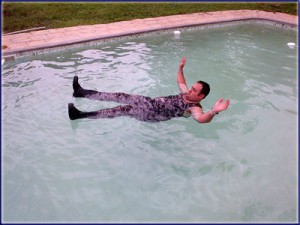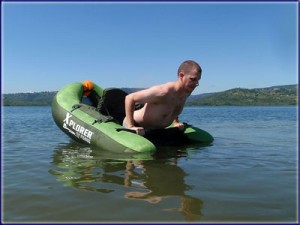There are many old fly fishing rumours, and this is where we bust them!
Swimming In Waders
One hears so many horror stories about waders and how fly fishermen drown in them because they fill up with water and make swimming near impossible. For safety reasons the Baha Boys decided to put this myth to the test.
So on a warm summer’s day Nick pulled on his waders and jumped in the swimming pool.
The first test was conducted using neoprene waders since these are what Nick usually fishes in. His first impression was that of surprise at just how buoyant the waders were. In fact he found it hugely reassuring that the waders kept him afloat without the need for him to try and swim.
Being neoprene and relatively tight the waders did a good job at keeping the water out. As such his second test was to fill the waders with water to get them neutrally buoyant. Again he was very surprised at how buoyant the waders remained. Although buoyancy was still good maneuverability was severely hampered, so although you won’t sink, it will be a tiring job to swim to shore…especially if the water is 8 degrees and you’re panicking.
Never the less, despite maneuverability being low, Nick felt confident to say that you’ll easily remain afloat if you keep your wits about yourself.
Knowing that PVC is perhaps a more common wader material than neoprene, Nick then pulled on a pair of PVC waders and repeated the test. Although not as buoyant as the neoprene, the PVC waders still offered decent floatation. One concern he had however was that the boots on the PVC waders were more buoyant that the rest of the waders. This meant that your feet floated to the surface making it more difficult to keep your head above water. It is worth noting that this will be different in stocking foot waders.
As with the previous test he then filled these waders with water to see what difference this would make. This proved to be more difficult than one would imagine due to the water pressure forcing the PVC tightly against his body. Once completely filled Nick again noted that the PVC waders were almost as buoyant as their neoprene counterparts.
Again Nick stated that as long as one keeps their wits about themselves they should be fine.
It must be noted that hypothermia is a real risk whilst trout fishing in winter. It’s important to get yourself dry and warm as soon as possible once you’ve gotten to safety. It’s also recommended to fish with a buddy so if you do find yourself in difficulty there’s someone close by to offer a helping hand.
Flipping Float Tubes
During a trip to Inanda Dam the water was incredibly warm (28 degrees to be precise) so when we got back to the car we spent half an hour or so testing the tipping point of our float tubes. Having often heard nasty stories of just how easily they flip, it seemed like the perfect opportunity to form our own opinions and to assess if there was any real danger.
With one of us at the ready to free the other we set about testing Nick’s Xplorer Journey and my Fishcat Deluxe.
We did manage to flip both tubes forwards, backwards and sideways, with forwards being by far the easiest of the directions. That said, it would be nearly impossible to do any of these by accident. In fact, tipping the tubes took a large amount of effort. The tubes also tipped incredibly slowly so there was plenty of time to notice what was happening and to correct it.
Since our initial tests were done without stripping aprons (for safety reasons), we manned up and repeated the tests with the aprons on. We were concerned that the bar on the Xplorer may trap the fishermen in the tube one flipped. This was far from the truth and we had absolutely no difficulty getting out of the tube once it had overturned.
Our next test was to see whether one was able to get back onto the tube in the middle of the dam. Both tubes were easy enough to climb back onto without touching the bottom. It did however take a little effort and older people may struggle a little with this. The Xplorer was slightly easier to climb back onto which I think was due to the harder foam seat rather than the inflatable seat in the Fishcat.
It is worth stating that these tests were done with fins on but without waders. This could make a slight difference since waders may lower one’s mobility slightly.
As you can see, these tubes are far safer than one gives them credit for. It is however still important to respect them and to use them with caution and logic. Only a fool would do otherwise…



[…] Fly Fishing Myth Busters […]